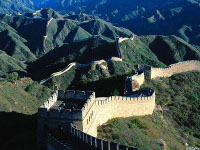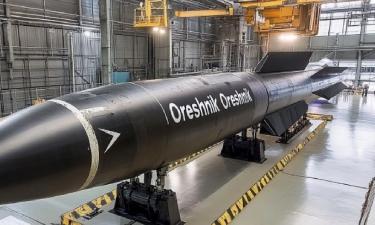USA considers scenario of war with China
The fact that the relations between China and the U.S. have been slipping into a confrontation similar to the Cold War has been discussed by media for two years, but for the first time these allegations began to take practical shape. Obama called China a "rival" and instructed to study the degree of nuclear threat posed by the country. The U.S. began redeploying its fleet in the Pacific Rim.

The reasons behind the confrontation are both economic and political. China is the world's only country capable of leaving the U.S. behind in terms of GDP in the near future (according to experts - 8 years from now). America is experiencing economic recession, high unemployment and a threat of a default. China is growing steadily, artificially maintaining low exchange rate of the yuan, which stimulates domestic production and exports. In addition, in recent years China has been withdrawing U.S. dollars from its foreign exchange reserves and investing them in gold, euros, and raw materials. The trend is clear - China no longer wants to be a creditor of the U.S.
The U.S. is concerned and trying to work through international institutions. For example, Obama signed a claim to the WTO, accusing the Chinese government of offering subsidies for Chinese auto companies. The U.S. lawmakers have actually recognized China as a manipulator in the currency pair yuan-dollar, and the U.S. imposed trade tariffs on twenty Chinese goods. However, this is a drop in the ocean. Actions similar to "Jason-Vanik" amendment are nowhere in sight. Why? Because the U.S. dependence on the Chinese economy is so high that by introducing such sanctions the United States would destroy its own industry that is being rapidly brought to China.
From a political point of view, first of all, these are two completely different systems. On the one hand - communist, collective, but isolated China, on the other - neo-liberal, individualistic U.S. Second, the political relations worsened after the adoption in January of 2012 of a new U.S. military doctrine, according to which the main area of its military presence has become the Asia-Pacific Region (APR).
The tense relations between China and Japan over territorial claims may lead the U.S. to a tough choice of joining the military conflict on the side of its ally. The same can be said with regard to the Philippines, with which the United States has a mutual defense treaty. China is flexing its muscles, staging military exercises in the Asia-Pacific region (including those shared with Russia), conducting cyber-attacks against the U.S., and bringing people into the streets at unprecedented anti-Japanese protests. In response, the Americans are conducting their exercises, trying to play a role of the arbiter in maritime disputes between China and its neighbors, entering into an agreement on the development of ballistic missiles with South Korea, creating a military base in Australia, etc.
The situation is deteriorating, and the USA is considering possible scenarios of a war with China, and even nuclear conflict. On January 2nd, Obama signed into law a new concept of national security, which ordered the U.S. Strategic Command (STRATCOM) by August 15th to submit a report on the underground network of tunnels in China and the U.S. capabilities to use conventional and nuclear forces to neutralize and destroy these tunnels. Director of the Nuclear Information Project at the Federation of American Scientists Hans Kristensen said that the lack of transparency in the intentions of both countries increases the risk of a war between China and the U.S. He said that the two countries are dancing a dangerous dance that increases military tension and could potentially lead to a small war in the Pacific.
Ian Bremmer, an American political scientist and president of Eurasia Group, said in an interview with Time that the current strategic relations between the two countries are very similar to the Cold War.
He said that the U.S. ideology has not changed, although it is not as powerful as before. Its main provisions are individual freedom, democracy, and free enterprise. But in recent years it has been hit hard, both by the financial crisis and the violation of human rights in Guantanamo and Abu Ghraib, as well as huge interest of corporations in the elections. Old institutions like the G-20 are no longer working. Bremmer acknowledged that the country was poorly prepared for the challenges of the Cold War.
In the end, experts said, if the U.S. wants to establish productive relations with China, it should create a strong foundation in the form of organizations that China is interested in joining. Ultimately, a club that the Chinese would want to join needs to be created, Bremer said. However, he provided no explanation on what this "club" would be like. A club against Russia? Quite the contrary, the Shanghai Cooperation Organization (SCO) where the United States is not present has been already established in Asia. Or is it a club where all Asia-Pacific countries will be playing against China? This is unlikely, because at the last summit of another regional association - the Association of South East Asian Nations (ASEAN) (which does not include China) in July of 2012 with U.S. Secretary of State Hillary Clinton, a strategy against China's actions in the disputed archipelago South China Sea has not been developed. Chinese allies are obvious - Cambodia, Thailand and Myanmar with which China has a powerful financial leverage.
Bremmer may be talking about an Agreement on Trans-Pacific Partnership that is seen in the U.S. as an instrument of the "return to Asia" and is intended to replace the APEC (that includes Russia and China). But China would not join an organization where the rules are dictated by the U.S. This means that creation of the said "club" is not realistic.
Lyuba Lulko
Pravda.Ru
Subscribe to Pravda.Ru Telegram channel, Facebook, RSS!


